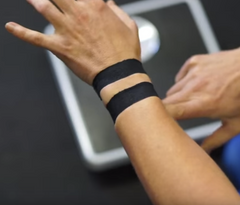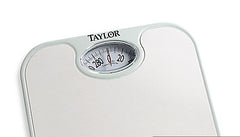Weight Bearing Test to determine Triangular Fibrocartilage TFCC tears
HOW TO PERFORM THE WEIGHT BEARING TEST
Use a NON-digital scale (also called dial, mechanical, or analog scales). They are available for less than $10 USD, OR perform the test on the scale in the store.

Record your results. Download Weight Bearing Test Log to measure your progress.
The Weight Bearing Test is the best way to know to test if you have a Triangular Fibrocartilage Complex (TFCC) tear
What is the Weight Bearing test and why is it important? The weight bearing test is a measure of how much weight you are able to pass through your wrist and hand. All you need is a non-digital analog scale. Digital scales are NOT effective.

The only injury that responds to taping of the wrist, or wearing a WristWidget® is the TFCC tear.
There is no other injury that changes your weight bearing tolerance when you bring the radius and ulna together, so the Weight Bearing Test becomes a diagnostic tool.
This is not the case for tendonitis, fractures, UT tears and much more. The Weight-bearing test is reliable, affordable and specific. - Wendy
------------------------
Why can't I use a digital scale?

Think of it this way... A digital scale measures static weight. A 10# bag of flour will weigh 10#.
We're actually looking for how much weight your wrist can bear, or perhaps better stated, your pressing ability. With an analog (non-digital) scale, you can see visually where your abilities lie and what the consistent weight bearing number is for your wrist.
The results from a digital scale give you an untrue value for the severity of your injury.
Understanding the Weight Bearing Test Results
The human wrist is capable of pressing 60-120 lbs. of weight on each wrist. If your injury is to the Triangular Fibrocartilage Complex (TFCC) and you're experiencing ulnar-sided wrist pain, you will notice that your uninjured wrist is normal and your injured wrist hurts when you push down on the scale. The test is not intended to hurt you. It is to measure where you are starting, where you need to go (the uninjured wrist) and the effects of the WristWidget®.
The Weight Bearing Test is often more reliable than an MRI in diagnosing a Triangular Fibrocartilage Complex (TFCC) and much, much less expensive.
RESULTS INTERPRETATION
Triangular Fibrocartilage Complex (TFCC) injury
- Significant difference between healthy and injured pressing ability
- Immediate increase in weight pressing ability with tape/WristWidget®
- Immediate reduction in pain
- Order a WristWidget® - Your TFCC will heal without surgery when our proven treatment protocol is followed.
Injured wrist test results WITHOUT tape/WristWidget®

Click here for Treatment Plans
Tendonitis or other non-TFCC injury
- Minimal difference in pressing ability with and without tape/WristWidget®
- Pressing ability with injured wrist is similar to that of healthy wrist
- Your wrist may ache when taped or wearing the WristWidget®
- You probably do NOT have a TFCC injury and the WristWidget® won't aid in healing.
What do I do until I get my WristWidget®?
Tape your wrist until WristWidget® arrives - YouTube. You will find that it will ease the pain that you are feeling. Please use pre-wrap under the athletic tape to prevent irritation from the tape adhesive. Protect the wrist. No lifting over 1 lb. Keep the elbow and shoulder moving and stretched.
How do I know if my wrist is healing?
Measure your weight bearing tolerance while wearing the WristWidget® every 7 days. This should be done to the edge before pain but no further. Record your measurements to keep track of your progress as your wrist heals. Follow the TFCC Recovery Protocol handout above. Your results should improve each week. If it does not, please contact us - let's see what's causing the delay.
I can press 65# with my bad wrist - do I have a tear? Am I healed?
If your uninjured wrist is able to press 100 lbs. and your injured wrist can press 65 lbs, you are functional yet still have a 35% loss.
So when it starts feeling great, resist the urge to start working your wrist as if it were unhurt. Be patient and wait until the uninjured and the injured (without the WristWidget®) wrist press the same weight. THEN and only then will you be at 100%.
How long do I have to wear the WristWidget®? How long does it take for a Triangular Fibrocartilage Complex (TFCC) tear to heal?
Healing time varies depending on the severity of the injury as well as how long you've had the TFCC tear. Most require 4-8 weeks of WristWidget® use, but up to 12 weeks is possible if you have a complete tear, or more if this has been a long-standing, untreated tear. This is a time investment that is worth making. Give your wrist the time needed to heal so you can be active again.
